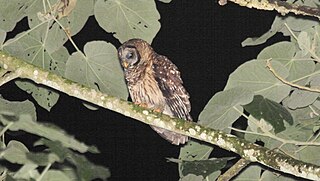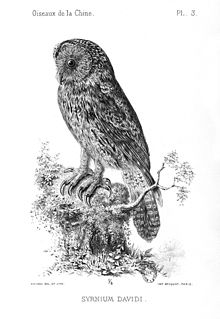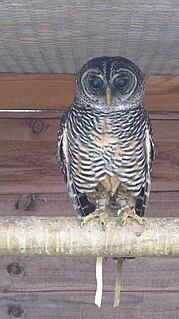 W
WStrix is a genus of owls in the typical owl family (Strigidae), one of the two generally accepted living families of owls, with the other being the barn-owl (Tytonidae). Common names are earless owls or wood owls, though they are not the only owls without ear tufts, and "wood owl" is also used as a more generic name for forest-living owls. Neotropical birds in the genus Ciccaba are sometimes included in Strix.
 W
WThe African wood owl or Woodford's owl, is a typical owl from the genus Strix in the family Strigidae which is widespread in sub-Saharan Africa.
 W
WThe barred owl, also known as the northern barred owl, striped owl or, more informally, hoot owl, is a North American large species of owl. A member of the true owl family, Strigidae, they belong to the genus Strix, which is also the origin of the family's name under Linnaean taxonomy. Barred owls are brown to gray overall, with dark striping on the underside contrasted immediately above that with similarly dark and tight barring about their throat and nape. Barred owls are largely native to eastern North America, but have expanded their range to the west coast of North America where they are considered invasive. Mature forests are their preferred habitat, but they can also acclimate to various gradients of open woodlands. Their diet consists mainly of small mammals, but this species is an opportunistic predator and is known to prey upon other small vertebrates such as birds, reptiles, and amphibians, as well as a variety of invertebrates.
 W
WThe black-and-white owl is a species of owl in the family Strigidae.
 W
WThe black-banded owl is a species of owl in the family Strigidae. Entirely nocturnal, this midsized black and white neotropical bird is a resident species, therefore never migrates out of its native South America. Its natural habitats are varied subtropical or tropical forests ranging from lowlands to areas of medium altitude, and it has been found in Argentina, Bolivia, Brazil, Colombia, Ecuador, French Guiana, Guyana, Paraguay, Peru, Suriname, and Venezuela.
 W
WThe Brown Wood Owl is found in India, Bangladesh, Sri Lanka, Indonesia, Taiwan, and south China. The brown wood owl is a resident breeder in south Asia. This species is a part of the family of owls known as typical owls (Strigidae), which contains most species of owl. It belongs to the earless owl genus Strix.
 W
WThe Chaco owl is an owl which inhabits dry Chaco woodland in southern Bolivia, western Paraguay and northern Argentina.
 W
WThe desert owl or desert tawny owl, formerly known as Hume's owl, is a species of owl. It is closely related to the more widespread tawny owl and to the range-restricted Omani owl.
 W
WThe fulvous owl, or Guatemala barred owl, is a resident of the cloud forests of Central America. A medium-sized true owl, it has a round head, lacking ear tufts. Typical coloration is warm dark brown or reddish brown on the back and lighter brown on the front with darker barring. Adults weigh approximately 600 grams (21 oz), with females being heavier. Its distribution is limited to highland regions of Guatemala, Honduras, and El Salvador. It inhabits elevations from 1,200 to 3,100 meters, and is fairly common within its range. Its behavior is poorly known, as are its population size and distribution. It is classified as a species of least concern by the International Union for Conservation of Nature, although it is considered endangered in Mexico.
 W
WThe great grey owl or great gray owl is a very large owl, documented as the world's largest species of owl by length. It is distributed across the Northern Hemisphere, and it is the only species in the genus Strix found in both Eastern and Western Hemispheres. In some areas it is also called Phantom of the North, cinereous owl, spectral owl, Lapland owl, spruce owl, bearded owl, and sooty owl.
 W
WThe Himalayan owl, also known as the Himalayan wood owl, is an owl of the forests of the Asia, from the Himalayas to Korea and Taiwan. It is sometimes considered a subspecies of the tawny owl, but is separated from that species due to its distinctive call, darker plumage and shorter, barred tail.
 W
WThe Maghreb owl is an owl of the earless owl genus, Strix. It occurs in northwestern Africa from Morocco to Tunisia and Mauritania. It was previously considered a subspecies of the tawny owl.
 W
WThe mottled owl is a medium-sized owl found in Central and South America from Mexico to Brazil and Argentina. The head and back are mottled brown and the underparts whitish, with vertical bars on the chest and throat. The eyes are dark and the head is round and they do not have ear tufts. They are territorial and found in dry forests and jungles at altitudes of up to 2,500 m (8,200 ft) above sea level.
 W
WThe mottled wood owl is a species of large owl found in India. They are found in gardens and thin deciduous forests adjacent to dry thorn forests or farmland. They are easily detected by their distinctive tremulous eerie calls at dawn and dusk. The characteristic call is a duet of the male and female while other notes include a low hoot and a screech. Their large size, lack of "ear" tufts and the concentric barring on the face make them easy to identify.
 W
WThe northern spotted owl is one of three spotted owl subspecies. A western North American bird in the family Strigidae, genus Strix, it is a medium-sized dark brown owl native to the Pacific Northwest. An important indicator species, the northern spotted owl remains threatened due to continued population decline from human-caused habitat destruction and competition with invasive species.
 W
WPère David's owl is an owl found in the mountains of central China. There is debate over whether it is a separate species or an isolated subspecies of Ural owl. The Clements Checklist of Birds of the World considers it separate, but BirdLife International and IUCN treat it as a subspecies.
 W
WThe rufous-banded owl is a species of owl in the family Strigidae. It is found in Bolivia, Colombia, Ecuador, Peru, and Venezuela.
 W
WThe rufous-legged owl is a medium-sized owl with no ear tufts. Its upper parts are rufous brown barred with white with more white on the head and nape. It has a rufous facial disk and dark eyes, and its legs and feet are orange-brown to cinnamon. It reaches sizes of about 33–38 cm long and weighs about 300-400 grams. Its range stretches from central Chile and west Argentina to Tierra del Fuego and is occasionally spotted on the Falkland Islands. It lives in dense, moist montane forest and semi-open lowland forest where it can catch small mammals, birds, and insects. It breeds in October and lays 2-3 eggs in a tree hollow. Its call is a rapid grunting followed by high pitched nasal noises. Though it is not threatened it does suffer habitat loss because of logging in a large part of its range.
 W
WThe rusty-barred owl is a species of owl distributed mainly in the south of Brazil and further inland to Paraguay and the extreme northeast of Argentina. The rusty-barred owl is one of only a few members of the genus Strix to be found in South America. It is elusive and probably quite rare, and as a result has been little studied. The classification in Strix is therefore probably only temporary, until more information can be gathered on the nature of the owl.
 W
WThe spotted owl is a species of true owl. It is a resident species of old-growth forests in western North America, where it nests in tree hollows, old bird of prey nests, or rock crevices. Nests can be between 12 and 60 metres high and usually contain two eggs. It is a nocturnal owl which feeds on small mammals and birds. Three subspecies are recognized, ranging in distribution from British Columbia to Mexico. The spotted owl is under pressure from habitat destruction throughout its range, and is currently classified as a near-threatened species.
 W
WThe spotted wood owl is an owl of the earless owl genus, Strix. Its range is disjunct; it occurs in many regions surrounding Borneo, but not on that island itself.
 W
WThe tawny owl or brown owl is a stocky, medium-sized owl commonly found in woodlands across much of the Palearctic. The tawny owl is a member of the genus Strix, that is also the origin of the family's name under Linnaean taxonomy. Its underparts are pale with dark streaks, and the upperparts are either rufous, brown or grey. Several of the eight recognised subspecies have each of the main colour variations. This nocturnal bird of prey hunts a wide variety of prey species, but usually primarily takes small mammals such as rodents. Tawny owls usually hunt by dropping from a perch to seize their prey, which they typically swallow whole. In more urban areas, its diet includes a higher proportion of birds, while in arid subtropics many invertebrates such as insects are taken. Other important prey can include frogs with other vertebrate prey taken fairly rarely. Vision and well-developed hearing adaptations combined with silent flight aid its night hunting. The tawny owl is capable of catching smaller owls, but is itself vulnerable to larger raptors, like eagle-owls or goshawks. This species typically nests in a tree hollow, wherein they are likely to gain protection of their eggs and young against potential predators. The tawny owl is non-migratory and highly territorial. Many young birds starve if they cannot find a vacant territory once parental care ceases. Although many people believe this owl has exceptional night vision, its retina is no more sensitive than a human's and its asymmetrically placed ears are key to its hunting by giving it excellent directional hearing. Its nocturnal habits and eerie, easily imitated call, have led to a mythical association of the tawny owl with bad luck and death.
 W
WThe Ural owl is a large nocturnal owl. It is a member of the true owl family, Strigidae. The Ural owl is a member of the genus Strix, that is also the origin of the family’s name under Linnaean taxonomy. Both its common name and scientific name refer to the Ural Mountains of Russia where the type specimen was collected. However, this species has an extremely broad distribution that extends as far west as much of Scandinavia, montane eastern Europe, and, sporadically, central Europe, thence sweeping across the Palearctic broadly through Russia to as far east as Sakhalin and throughout Japan. The Ural owl may include up to 15 subspecies, but most likely the number may be slightly fewer if accounting for clinal variations.